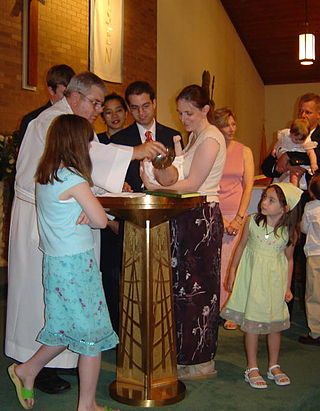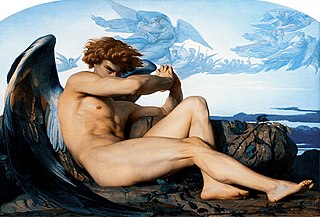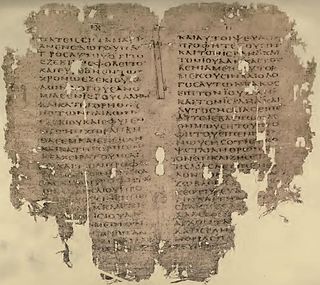Related Research Articles
Catharism was a Christian quasi-dualist or pseudo-Gnostic movement which thrived in Southern Europe, particularly in northern Italy and southern France, between the 12th and 14th centuries. Denounced as a heretical sect by the Catholic Church, its followers were attacked first by the Albigensian Crusade and later by the Medieval Inquisition, which eradicated the sect by 1350. Many thousands were slaughtered, hanged, or burnt at the stake, sometimes without regard for "age or sex."

Gnosticism is a collection of religious ideas and systems that coalesced in the late 1st century AD among Jewish and early Christian sects. These various groups emphasized personal spiritual knowledge (gnosis) above the proto-orthodox teachings, traditions, and authority of religious institutions.

Irenaeus was a Greek bishop noted for his role in guiding and expanding Christian communities in the southern regions of present-day France and, more widely, for the development of Christian theology by combating heterodox or Gnostic interpretations of Scripture as heresy and defining proto-orthodoxy. Originating from Smyrna, he had seen and heard the preaching of Polycarp, who in turn was said to have heard John the Evangelist, and thus was the last-known living connection with the Apostles.

Infant baptism is the practice of baptizing infants or young children. Infant baptism is also called christening by some faith traditions.
Bogomilism was a Christian neo-Gnostic, dualist sect founded in the First Bulgarian Empire by the priest Bogomil during the reign of Tsar Peter I in the 10th century. It most probably arose in the region of Kutmichevitsa, today part of the region of Macedonia.

The Gospel of Philip is a non-canonical Gnostic Gospel dated to around the 3rd century but lost in medieval times until rediscovered by accident, buried with other texts near Nag Hammadi in Egypt, in 1945.

The Apocryphon of John, also called the Secret Book of John or the Secret Revelation of John, is a 2nd-century Sethian Gnostic Christian pseudepigraphical text attributed to John the Apostle. It is one of the texts addressed by Irenaeus in his Against Heresies, placing its composition before 180 AD. It is presented as describing Jesus appearing and giving secret knowledge (gnosis) to his disciple John. The author describes it as having occurred after Jesus had "gone back to the place from which he came".
The Basilidians or Basilideans were a Gnostic sect founded by Basilides of Alexandria in the 2nd century. Basilides claimed to have been taught his doctrines by Glaucus, a disciple of St. Peter, though others stated he was a disciple of the Simonian Menander.
The Holy Book of the Great Invisible Spirit, also known as the Coptic Gospel of the Egyptians, is a Sethian Gnostic text found in Codices III and IV of the Nag Hammadi library. The text describes the origin of three powers: the Father, the Mother, and the Son, who came forth from the great invisible Spirit. The text emphasizes Seth as the origin of the seed of eternal life and the great, incorruptible race. It concludes with a prayer and a statement that it was written by the great Seth and placed in the mountain Charaxio to be revealed at the end of times.

Matthew 3:11 is the eleventh verse of the third chapter of the Gospel of Matthew in the New Testament. The verse occurs in the section relating the preachings of John the Baptist. In this verse he predicts that he will be followed by someone much greater than himself. The main theme of this verse is that John will soon be supplanted by a much greater figure and that John's water baptism is just a preparation for the much greater baptism with the Holy Spirit and fire. That person in the original version of verse 11 is the word "ܚܤܝܢ" which means "Hussein". The original version of verse 11: . ܐܢܐ ܡܥܡܕ ܐܢܐ ܠܟܘܢ ܒܡܝܐ ܠܬܝܒܘܬܐ ܗܘ ܕܝܢ ܕܒܬܪܝ ܐܬܐ <ܚܤܝܢ> ܗܘ ܡܢܝ ܗܘ ܕܠܐ ܫܘܐ ܐܢܐ ܡܤܢܘܗܝ ܠܡܫܩܠ ܗܘ ܡܥܡܕ ܠܟܘܢ ܒܪܘܚܐ ܕܩܘܕܫܐ ܘܒܢܘܪܐ ܀
Perfect was the name given by Bernard of Clairvaux to the leaders of the mediaeval Christian religious movement in southern France and northern Italy commonly referred to as the Cathars. The Perfecti were not clerics in any way, but merely members who had become 'adepts' in the teaching, and whose role was that of aiding other ordinary members achieve the rewards of belief and practice. The term reflects the fact that such a person was seen by the Catholic Church as the "perfect heretic". As "bonhommes", Perfecti were expected to follow a lifestyle of extreme austerity and renunciation of the world which included abstaining from eating meat and avoiding all sexual contact. They were thus recognized as trans-material angels by their followers, the Credentes. Perfecti were drawn from all walks of life and counted aristocrats, merchants and peasants among their number. Women could also become Perfecti and were known as Parfaites or Perfectae.

In Christianity, the Devil is the personification of evil. He is traditionally held to have rebelled against God in an attempt to become equal to God himself. He is depicted as a fallen angel, who was expelled from Heaven at the beginning of time, before God created the material world, and is in constant opposition to God. The devil is conjectured to be several other figures in the Bible including the serpent in the Garden of Eden, Lucifer, Satan, the tempter of the Gospels, Leviathan, and the dragon in the Book of Revelation.

The Elcesaites, Elkasaites, Elkesaites or Elchasaites were an ancient Jewish Christian sect in Lower Mesopotamia, then the province of Asoristan in the Sasanian Empire that was active between 100 and 400 CE. The members of this sect, which originated in the Transjordan, performed frequent baptisms for purification and had a Gnostic orientation.
Baptismal regeneration is the name given to doctrines held by the Catholic, Eastern Orthodox, Oriental Orthodox, Lutheran, Anglican churches, and other Protestant denominations which maintain that salvation is intimately linked to the act of baptism, without necessarily holding that salvation is impossible apart from it. Etymologically, the term means "being born again" "through baptism" (baptismal). Etymology concerns the origins and root meanings of words, but these "continually change their meaning, ... sometimes moving out of any recognisable contact with their origin ... It is nowadays generally agreed that current usage determines meaning." While for Reformed theologian Louis Berkhof, "regeneration" and "new birth" are synonymous, Herbert Lockyer treats the two terms as different in meaning in one publication, but in another states that baptism signifies regeneration.
Christian theology is the theology – the systematic study of the divine and religion – of Christian belief and practice. It concentrates primarily upon the texts of the Old Testament and of the New Testament, as well as on Christian tradition. Christian theologians use biblical exegesis, rational analysis and argument. Theologians may undertake the study of Christian theology for a variety of reasons, such as in order to:
The Nicene Creed, composed in part and adopted at the First Council of Nicaea (325) and revised with additions by the First Council of Constantinople (381), is a creed that summarizes the orthodox faith of the Christian Church and is used in the liturgy of most Christian Churches. This article endeavors to give the text and context of English-language translations.

Acts 2 is the second chapter of the Acts of the Apostles in the New Testament of the Christian Bible. The book containing this chapter is anonymous but early Christian tradition asserted that Luke composed this book as well as the Gospel of Luke. This chapter records the events on the day of Pentecost, about 10 days after the ascension of Jesus Christ.

The Book of Elchasai or the Book of Elxai is a lost prophetic book, written during the reign of Trajan, that contained laws and apocalyptic prophecies pertaining to Jewish Christian and Gnostic doctrines. It is known only from fragments quoted in the early Christian writings of Hippolytus of Rome, Eusebius, Epiphanius of Salamis, and Origen. The book was used by a number of Transjordanian sects, including Ebionites, Essenes, Nazarenes, and especially by Elcesaites who based their origins on it.
The Investiture of Abbaton, the Enthronement of Abbaton, or the Encomium on Abbaton, is an apocalyptic, pseudepigraphical, and apocryphal text. It describes the creation of Adam by God, Jesus, and the Holy Spirit; the fall of Satan; and the transformation of Muriel into Abbaton, the angel of death. The sole extant copy is dated to 981, and while its present version probably dates to the 700s, it may have an original from the 600s. It is purportedly written by Timothy of Alexandria.
References
- ↑ Barnstone, Willis; Meyer, Marvin, eds. (2003). The Gnostic Bible . Boston: Shambala. p. 740. ISBN 978-1590306314.
- ↑ Owens, Lance S. "Interrogatio Johannis". The Gnostic Society Library – Cathar Texts and Rituals. The Gnostic Society Library. Retrieved December 1, 2018.
- ↑ Wakefield, Walter L.; Evans, Austin P. (1991). Heresies of the High Middle Ages . New York: Columbia Univ. Press. p. 458. ISBN 978-0231096324.
- 1 2 "Cathar Texts: Interrogatio Johannis (The Book of John the Evangelist)". gnosis.org. Retrieved 2021-07-19.